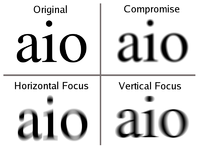
Photo from wikipedia
Objectives To review the pattern of primary pterygium-induced corneal astigmatism in patients with cataract in a southern Chinese population. Design Clinic-based cross-sectional retrospective study. Setting A secondary hospital at southern… Click to show full abstract
Objectives To review the pattern of primary pterygium-induced corneal astigmatism in patients with cataract in a southern Chinese population. Design Clinic-based cross-sectional retrospective study. Setting A secondary hospital at southern China. Participants A group of 1689 eyes with primary pterygium (PT group) and the other group of 4062 eyes without pterygium (NPT group) were included. Main outcome measures Corneal power was measured by an autokeratorefractometer. Corneal astigmatism was calculated as the difference in corneal power between the steepest and flattest meridians. Distribution of corneal astigmatism was compared between eyes with pterygium and eyes without pterygium. Results Distribution of corneal astigmatism was different between PT group (skewness=2.548, kurtosis=8.237) and NPT group (skewness=2.778, kurtosis=15.52). Mean corneal astigmatism was significantly higher in the PT group (1.62±1.49D) compared with the NPT group (1.17±0.89D, p<0.0001). The prevalence of corneal astigmatism >1D (PT 52.3%, NPT 40.9%, p<0.0001), >2D (PT 22.4%, NPT 10.6%, p<0.0001) or >3D (PT 10.5%, NPT 3.2%, p<0.0001) was significantly higher in the PT group compared with the NPT group. Eyes in the PT group had significantly higher corneal astigmatism than the NPT group in almost every age group (all p<0.05), with the exception of patients ≥90 years. Moreover, eyes in the PT group had significantly higher with-the-rule (PT 1.72±1.59D, NPT 1.19±0.88D, p<0.0001) and against-the-rule (PT 1.63±1.46D, NPT 1.18±0.88D, p<0.0001) but similar oblique astigmatism (PT 1.11±1.00D, NPT 0.99±0.89D, p=0.065) corneal astigmatism compared with the NPT group. Power vector analysis indicated that the axis of corneal astigmatism was not significantly different between the two groups (J0, PT −0.01±0.74D, NPT 0.01±0.52D, p=0.48; J45, PT −0.03±0.82D, NPT 0.00±0.52D, p=0.54). Conclusions Pattern of corneal astigmatism in eyes with cataract and coexisting primary pterygium was different from eyes without pterygium. Pterygium is associated with higher magnitude but not different axis of corneal astigmatism.
Journal Title: BMJ Open
Year Published: 2020
Link to full text (if available)
Share on Social Media: Sign Up to like & get
recommendations!